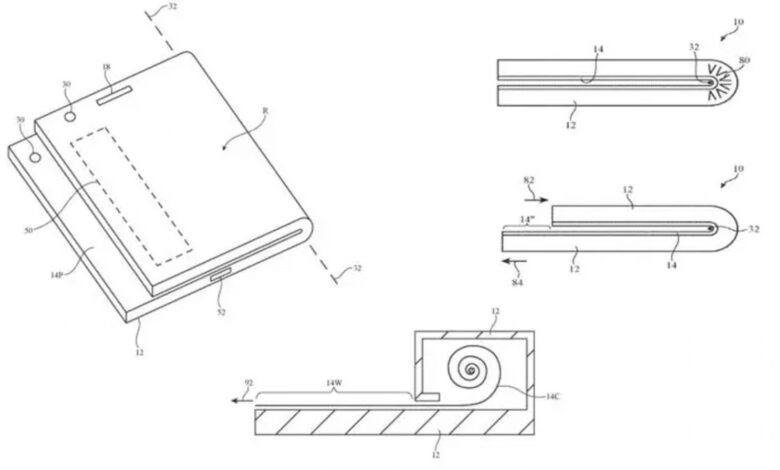Apple is potentially working on a foldable iPhone

Apple is potentially working on a foldable iPhone
In recent years, there has been significant interest and anticipation regarding the development of foldable devices by Apple, especially in the smartphone industry. With the advent of foldable screens on products like the Samsung Galaxy Fold and the Motorola Razr, the concept of foldable devices has become a reality.
Therefore, it is unsurprising that major technology companies such as Apple are actively researching and investing in this technology to create their own foldable devices. Apple has recently been granted several patents that suggest the company is exploring new methods to transform every inch of the device into an input surface, even when it is folded up in a clamshell design.
The development of foldable screen technology possesses the potential to transform the way we engage with our devices, paving the way for new opportunities in design and functionality. However, what is the rationale behind securing a patent for this technology, and how might it be advantageous for a company like Apple?
Acquiring a patent for foldable screen technology provides Apple the means to safeguard their intellectual property and ensure that their competitors cannot infringe upon their particular designs. This, in turn, furnishes Apple with a competitive edge in the marketplace and grants them control over the production and dissemination of their foldable devices.
Moreover, investing in foldable screen technology is in keeping with Apple’s strategy of producing innovative and groundbreaking products that capture the attention of consumers. By introducing a revolutionary design, Apple can create hype around their new product and potentially acquire a significant market share. Ultimately, the patent for foldable screen technology is a strategic investment that has the potential to strengthen Apple’s competitive position in the marketplace and enable them to develop products that excite and captivate consumers.
Further details about the patent
Apple is a renowned company for its innovation and cutting-edge technology, and its recent patents for a foldable device demonstrate that it is committed to leading the way in this emerging market. By securing a patent for its foldable screen technology, Apple is safeguarding its investment in research and development while giving itself a competitive advantage over other companies that may be considering similar devices.
Apple has a lengthy track record of using patents to protect its intellectual property and dominate the market for its products, and the patent for its foldable screen technology is a prime example of this strategy. The patent outlines how touch sensor layers can be “overlapped” by the outer panels of a device. These sensors can be situated beneath a glass layer along the front, bottom, and curved sidewalls of a device, suggesting that Apple is testing features that allow touch inputs on virtually every surface area of a device.
Related: Apple releases a fix for the latest zero-day hack that’s been exploited
Additionally, the patent alludes to the possibility of “wrapping a display around some or all of device,” indicating that Apple has considered rounded sidewalls to enable touch sensor capability.
Could Apple’s foldable be better than the current options?
Apple has been transitioning towards creating iPhones that are large, tactile surfaces that feature minimalistic outer buttons or notches. According to the patent, sidewall touch sensors could be employed to regulate the camera, volume slider, or other sliders for adjusting brightness or contrast.
These sensors located on the backplate could also be utilized in gaming applications and other uses to exhibit the action while not obstructing any portion of the screen.
The potential drawback of having touch inputs covering virtually every surface area of a device would be its vulnerability. It could become fragile, particularly since it would imply that users couldn’t utilize a standard phone case without forfeiting some input space. Nevertheless, the patent describes walls constructed of “transparent and opaque materials” such as plastic, metal, or fiber-composite materials, or coatings of clear glass or plastics that could alleviate this concern.
Apple’s patent alludes to how “foldable electronic devices” can achieve some degree of touchability using a clamshell design. It entails an “elastomeric material” that enables the device to flex, with transparent touch sensors still activated along the walls of the device. The patent also refers to “an enclosure that permits a device to be folded one or more times along one or more fold axes,” although it is unclear if there would be any demand or benefit to folding a device more than once.
Only time will tell
There has been some debate among prominent Apple analysts and industry observers regarding whether Apple could introduce a foldable Mac/iPad hybrid in the coming year. Although patents are not always a reliable predictor of future products, these latest patents suggest that Apple is at least contemplating a more foldable future for its devices. As technology continues to advance, it remains to be seen what Apple will ultimately do with this research.
Thank you for being a Ghacks reader. The post Apple is potentially working on a foldable iPhone appeared first on gHacks Technology News.
gHacks Technology News
